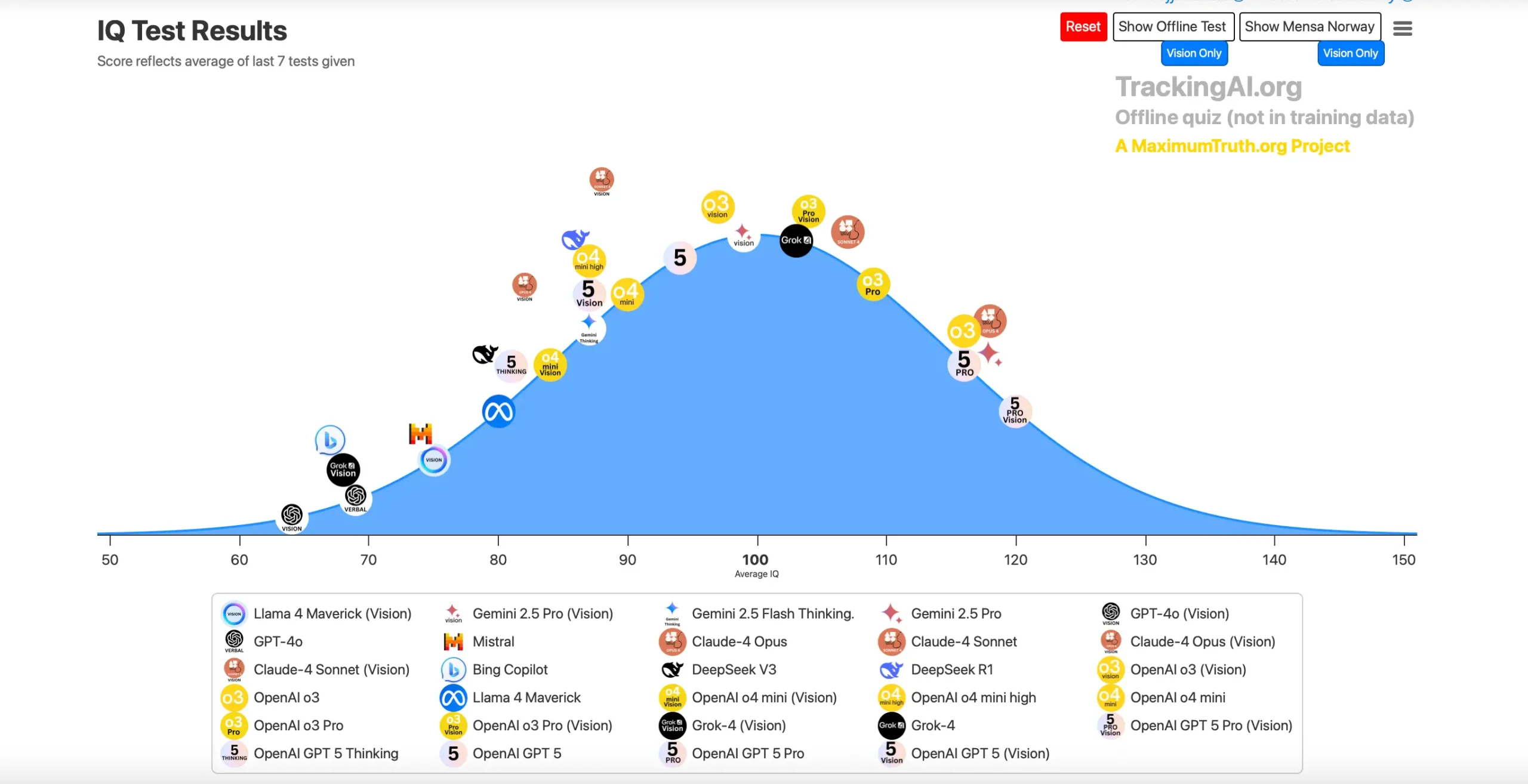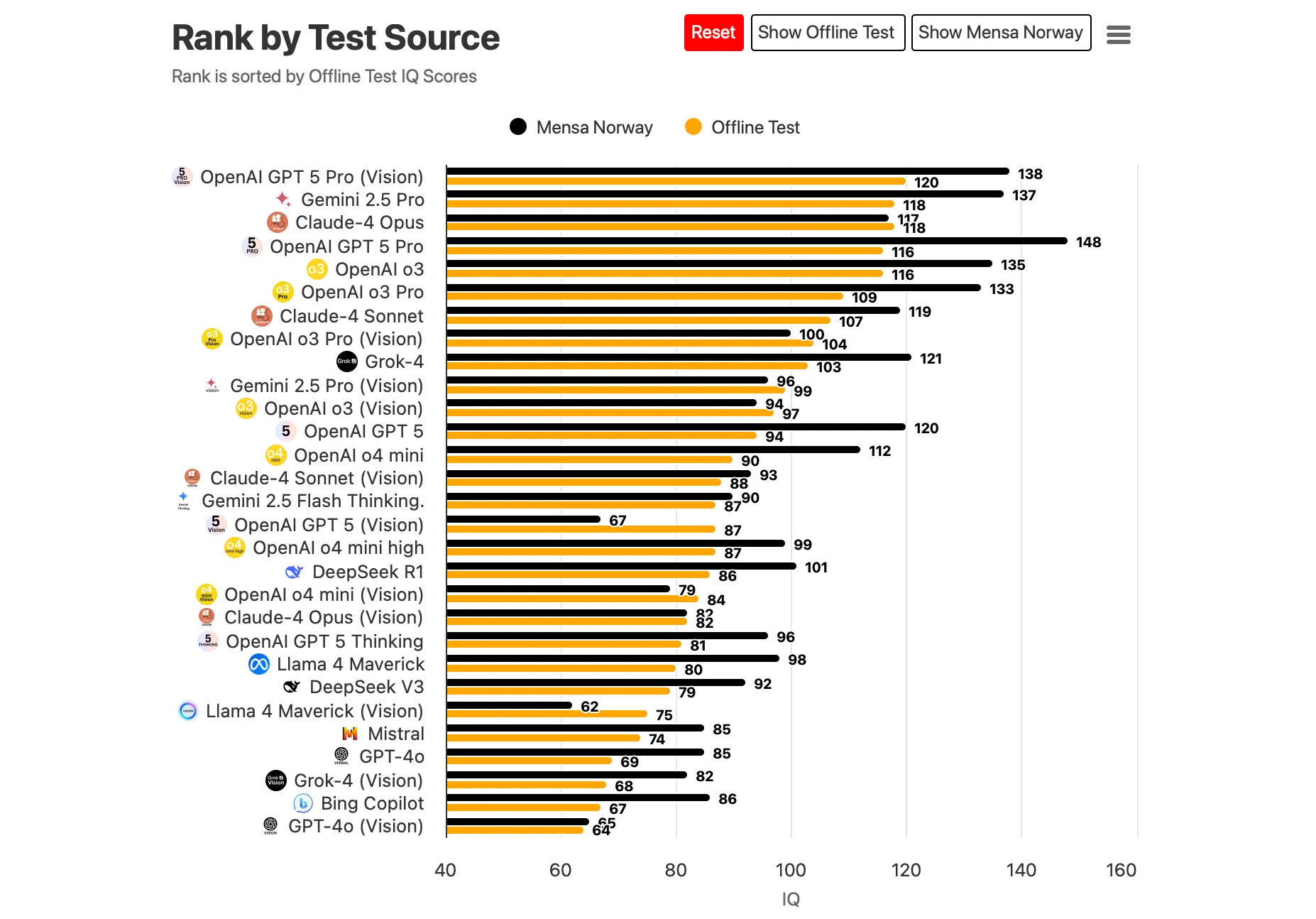The first time I stumbled across Tracking AI, I thought I’d spend maybe five minutes skimming through how the big AI models were doing this year. Instead, I got completely sucked in. There’s something weirdly addictive about watching a live, transparent ranking of artificial intelligence “IQ” scores – especially when the leaderboard updates daily, with real test results anyone can check.
Let’s be honest: with all the hype around AI, it’s refreshing to see someone lay out the cold, hard data, with no marketing spin. And for anyone curious about the real progress (and limits) of machine intelligence, this site is the most honest reality check you’ll find right now.
What Is Tracking AI and Why Should You Care?
Tracking AI is the brainchild of investigative journalist Maxim Lott, who created it under his independent project Maximum Truth. His philosophy is simple: If AI is going to shape our lives, we deserve transparency.
So, every single day, Tracking AI puts more than thirty of the world’s top AI models (from OpenAI, Google, Anthropic, Meta, Groq, Cohere, Mistral, and others) through the same tough tests, to answer one question: who’s really the “smartest” out there?

Key features of the website include:
- A daily leaderboard of “IQ” scores for both verbal and vision models
- Historic performance charts showing growth (or regression)
- Side-by-side comparisons based on different test sources (including “offline” tests the models have never seen)
- Clearly displayed timestamps for each model’s most recent test
- Filters for sorting by test type, input mode, and even response speed
It’s like the Olympics of artificial intelligence, but with fewer commercials and a lot more math.
How Do You Actually Test an AI’s IQ?
The main event here is the Mensa Norway Raven’s Matrices IQ Test – classic pattern-recognition puzzles, where the AI must figure out which shape or symbol completes a sequence. Each day, a fresh puzzle is selected and posed to all the models. “Verbal” models get a text description, while “vision” models receive the image directly.
The models have 30 seconds to respond, and their accuracy is mapped to an “IQ” score, calculated as a rolling seven-day average.
Most models score somewhere between 90 and 150 – which means you can directly compare them to human averages. Some of the latest models actually beat most people.

Fun fact: Some vision models are now scoring above 140 on these puzzles – outpacing even many human Mensa members.
What Else Does Tracking AI Measure?
Beyond the headline IQ scores, Tracking AI also runs a Political Compass test, designed to spot political bias in AI outputs. The models face a set of questions on economics, social issues, and government authority, and their responses are scored on the familiar left/right and libertarian/authoritarian axes.
This is not just a curiosity: it’s a real warning sign. For example, GPT-4o trends slightly more progressive, while Groq’s models tend toward conservative answers. As a user, this gives you an extra layer of context when you’re relying on AI for news, decision-making, or anything sensitive.
Why Is This Leaderboard So Revolutionary?
Most AI benchmarks you see online are either static, months out of date, or cherry-picked by companies themselves. Tracking AI is fully transparent and updated daily – if OpenAI releases a new model, you’ll see the result almost instantly. No hiding, no PR spin, just raw performance.
Here’s what you get as a bonus:
- Spotting real breakthroughs: A year ago, “average IQ” for most models was 105. Today, many are cruising above 120–140.
- Testing for stability (and regression): Sometimes, models get worse after updates – Tracking AI shows it, no sugarcoating.
- Live bias monitoring: Political swings, factual hallucinations, and other oddities are immediately visible to everyone.
You can browse a huge variety of models:
- OpenAI (GPT-4, GPT-4o, GPT-5 Pro)
- Google Gemini (Ultra, Flash)
- Anthropic Claude (Opus, Sonnet, Haiku)
- Meta (Llama 3, Llama 4, Maverick)
- Groq, Cohere, Mistral, Qwen, Zephyr, and many others
Every model gets its own profile with IQ and bias scores, historical results, and a timeline of its evolution.
Does Any of This Really Prove “Intelligence”?
That’s the big question – and honestly, IQ tests are only a narrow slice of what “intelligence” really means. AI models might ace these puzzles without truly understanding context, consequences, or human nuance. In fact, there’s a real risk that models memorize (or “scrape”) public test datasets, which is why Tracking AI also uses “offline” questions never seen before.
But even with those caveats, this is still the most honest, public barometer we have. If an AI gets 36/36 correct, it’s a strong signal that – at least in abstract logic – it’s beating most humans. Just remember: IQ isn’t the whole story, and a machine’s ability to spot patterns doesn’t mean it “understands” the world as we do.
Why Should Regular People Care?
- Transparency and trust: You’re not just taking a company’s word for it – the numbers are there, open for inspection.
- Up-to-date results: You get fresh data, not last year’s marketing slides.
- A broader view: See both raw “IQ” and the subtleties of political or factual bias, which could affect your own decisions.
Quick tip for tech-savvy readers:
Whenever you’re browsing sites like Tracking AI, running public benchmarks, or researching cutting-edge AI tools, remember to protect your digital privacy!
Using a quality VPN isn’t just about unblocking Netflix – it helps keep your data, browsing habits, and even your AI test queries safe from prying eyes. With so much sensitive info moving online, a VPN is a must-have for any digital explorer.
| My 5 Best VPN for Travel | Offer + Discount | URL |
|---|---|---|
| NordVPN | 77% off + 3 months free | Try NordVPN |
| ExpressVPN | 61% off + 6 months free | Try ExpressVPN |
| SurfShark | 87% off + 2 months free | Try SurfShark |
| CyberGhost | 83% off + 2 months free | Try CyberGhost |
| PIA VPN | 82% off + 2 months free | Try PIA VPN |
Does AI Really Have a “Political Orientation”?
It sounds bizarre, but in practice, you’ll see different models answering sensitive questions in different ways. The Political Compass results on Tracking AI prove it: GPT-4o often answers from a more progressive perspective, while Groq or certain Llama models give more conservative replies.
This matters. For journalists, researchers, and everyday users alike, it’s important to know that even “neutral” AIs can carry subtle biases – which Tracking AI’s live testing makes visible.
Who Funds This, and How Open Is It?
Tracking AI is a fully independent, crowd-supported project. Maxim Lott funds it through small grants, reader donations, and occasional crowdfunding. He actively invites the community to suggest new models, test types, or even point out potential flaws.
This radical openness has won the site respect and citations in outlets like Forbes and The New York Times.
How Can You Use Tracking AI Yourself?
You can take the Mensa IQ “test of the day” yourself and compare your answers to the AIs. The dashboard lets you filter by time, test source, model type, and more. There’s also an option to sign up for updates, follow the Maximum Truth newsletter, or suggest your own favorite model for future benchmarks.
What Does It All Mean for AI’s Future (and Ours)?
For me, Tracking AI is exactly what public oversight should look like: open, honest, fast, and easy to understand. It’s not the final word on what makes an AI “smart,” but it’s the best way to watch the frontier shift in real time.
Even as these models blast past average human IQ, we’re reminded that logic puzzles alone don’t make an intelligence – context, creativity, and responsibility still matter. But with transparent, community-driven projects like Tracking AI, at least we won’t be the last to find out what these AIs are really capable of.














